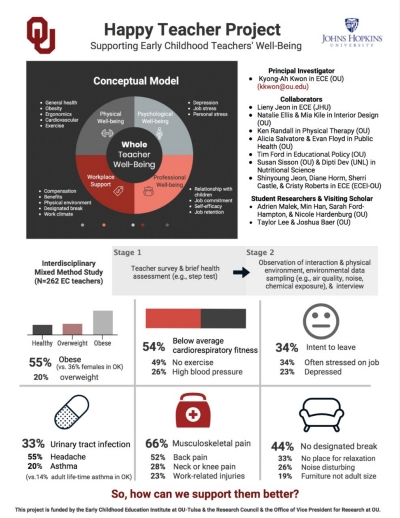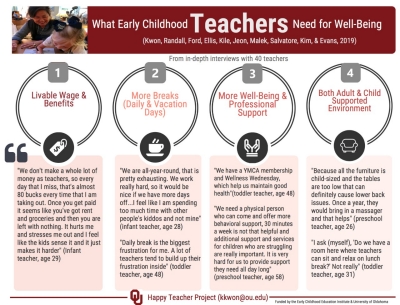It Takes a Village to Study and Support Whole Teacher Well-Being
The Happy Teacher Project takes a holistic and comprehensive approach by studying physical, psychological and professional well-being and how workplace conditions support these three areas.
When I began shaping our research questions, I immediately recognized that my greatest challenge would be that studying all four areas required a diverse team of researchers from a range of fields. So, I built a strong interdisciplinary team of researchers and experts in early childhood education, physical therapy, interior design, educational policy, public health and nutrition, who shared the vision and passion to improve the lives of early childhood teachers.
Our research team collaboratively designed the study, collected data and developed recommendations for improvement. We believe this strong interdisciplinary collaboration makes it possible to facilitate discussion among experts across fields and to develop comprehensive and systematic ways to support whole teacher well-being.
What We Learned About Early Childhood Teacher Well-Being
Since December 2018, we have followed a group of 262 early childhood teachers across 38 early childhood centers in Tulsa, measuring these different aspects of whole teacher well-being. We divided our research into two phases and gathered data through surveys, interviews, observations and direct health assessment.
During the first phase, we surveyed educators about their well-being, designing questions to better understand their physical and mental health, job-induced stress, work-related injuries and job commitment. We also measured teachers’ weight for obesity and administered a step test for cardiorespiratory fitness. Then, we investigated what types of workplace supports were in place to improve teachers’ well-being, such as compensation, benefits, designated breaks, paid sick leave, work climate and the quality of their physical environment.
During the second phase, we observed different aspects of the learning environment in 40 classrooms including teacher-child interactions and environmental factors, such as noise level, air quality, lighting and furniture. Then we interviewed 40 teachers about what they need to improve their well-being.
What we found shocked us, but ironically, when we shared the results with teachers and administrators, nobody was surprised.
The good news is that the majority of teachers we surveyed viewed their job as a profession and felt committed to their work with children. The majority plan to stay in the current position.
The bad news is that many early childhood teachers in Tulsa are facing serious issues with their physical and psychological well-being, which is consistent with recent studies of early childhood teachers in other states such as North Carolina, Pennsylvania, Washington and Texas.
The teachers in our study face significantly more physical health challenges than the general population. For example, three quarters were overweight or obese. Most had below average cardiorespiratory fitness. And a third reported doctor-diagnosed urinary tract infections. Additionally, about one-third of the teachers in our study frequently felt stressed while on the job; 23% felt depressed.
Two-thirds of the teachers in our study also had ergonomic pain in at least one area of the body. This is likely because teachers of young children constantly bend, reach, twist and squat in environments that are typically child size, earning them the nickname “educational athletes” by a physical therapy researcher on our team.
Furthermore, we collected and analyzed data on teachers’ body postures during routine activities and analyzed them using the Rapid Entire Body Assessment, a tool that evaluates the whole body for risk of musculoskeletal injuries. According to the results, most of the routine tasks teachers do daily carry moderate-to-high risk for physical injury. The following three actions fall into the high-risk category.
- standing while holding and reaching
- sitting and reaching
- stooping while holding
The most alarming news was revealed when we looked at the results of our study through the lens of teacher qualifications. Our survey findings revealed that teachers with higher education levels earned more and had better benefits. When we looked at the classroom observation data collected in phase two with a sample of 40 teachers for assessing instructional and social emotional care quality, we found that teachers with higher educational levels provided higher quality care.
At the same time, these teachers also reported poorer physical well-being with more ergonomic pains and job-induced injuries than teachers with lower qualifications. They also reported that they consider leaving their jobs more often than teachers with lower educational levels. This is concerning because teachers providing high-quality care are the very people we want to target in recruitment and retention efforts to build a high-quality workforce.




